|
Balaha
The horse that the merchant Samhala rescued and
that embodied one of the former incarnations of the Buddha.


Balarama (बलराम)
The older brother of Krishna and avatar of Vishnu.

Bali (พาลี)
Thai. A king of the monkeys and a brother of the
monkey king Sugriva who usurped his throne, in the Thai epic Ramakien.
In the Ramayana he is known by his Sanskrit name Vali and in Thai his
name is pronounced 'Phali'.

Bana
An asura that struggled with Krishna and is a son
of Bali.

bansuri (बांसुरी)
Hindi. Name for an ancient, northern Indian style,
transverse flute associated with cowherds and with the love story of
Krishna, who was a master of this simple musical instrument, with which
he is often portrayed. It consists of a single length of bamboo with
open finger holes. The Hindi name has its roots in the Sanskrit words
vamza meaning both 'flute' and 'bamboo' or 'bamboo cane', and svara
meaning 'musical note'. Krishna's flute is also referred to by the name
vamsi.

banyan tree
Sacred tropical tree with many
aerial roots that develop into additional trunks. Its name often refers
specifically to the species ficus bengalensis, though the term has been
generalized to include all figs that share this unique life cycle and
are known by the informal name of strangler fig. The name banyan comes
from the Gujarati word bania, meaning 'trader' or 'merchant', and refers
to the Indian merchants that would meet underneath this tree to conduct
their business and sell their goods, as it provided a shaded place. In
Hinduism it is the tree under which the god Vishnu was born, and in
Buddhism it is known as the tree under which the Buddha stayed for seven
days, after gaining Enlightenment. It is often confused with the bodhi
tree, the tree under which the Buddha sat at the moment he attained
bodhiyan or Enlightenment. In Thailand the base of a banyan tree is also
used to dispose of old or damaged spirit houses.


Ba
Xian (八仙)
The Eight Immortals from Chinese mythology, worshipped by most Chinese.
They are usually depicted together on a raft crossing the ocean from
their home in the Taoist paradise to worship Xi Wangmu, Queen Mother of
the West and mother of the Jade Emperor, after attaining their
Enlightenment. The mother of the supreme god is also the guardian of the
Peaches of Immortality, an attribute often accompanying the Eight
Immortals. They are known by the names: Chung-li Chuan, Li Tieh-kuai, Lu
Tong-pin, Chang Kuo Lao, Ho Hsien-ku, Lan Tsai-ho, Han Hsiang Tzu and
Tsao Kuo-chiu. In iconography they often hold an attribute for
recognition.


Benyagai
Sanskrit. Demon daughter of Phiphek, the chief
astrologer of Longka, and Drichada, in the Thai Ramakien. She has
learned magical powers from her father, and with these she changes
herself, at Totsakan's urging, into Sida. According to the plot she has
to play dead near the monkey camp of Phra Ram, hoping that the latter
would cease his quest for his beloved and end the battle against the
demons. Benyagai visits the captured Sida to study her appearance before
changing herself into her. But, the plan fails nonetheless thanks to the
sharp attentiveness of Hanuman, and Benyagai is sent back to Longka.

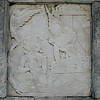
Bhadeshvara
Khmer-Sanskrit. Name under which the followers of
Shivaism from the 5th century AD in Cambodia worshiped the Hindu god
Shiva. The king himself would bring honor to special ceremonies in which
a sacred mountain was climbed at night and a rite was performed in
which, according to rumours of Chinese inhabitants at Angkor, human
sacrifices were also involved.

Bhadra (भद्र)
Sanskrit. Name of one of the eighteen arahats, who
was a cousin of the Buddha and one of his great disciples. His Sanskrit
name has many meanings, including 'auspicious', 'kind', 'gracious',
'blessed', 'skillful', etc. It is said that he was a proficient
preacher, who could expound in clear and simple language. According to
legend, he spread Buddhism to the East Indies, thus fording many rivers
and crossing several seas, reportedly sailing from India to the island
of Java. He is commonly portrayed with a beard and a sack on a stick,
worn over his shoulder and in which he bears the sutras. In Thai his
name is pronounced Phatra, but he is also called Chatohloh. In Chinese
he is known as the luohan Guo Jiang, literally 'To Pass Through a Large
River'. In English he is referred to as the Oversea Lohan or the Arhat
Who Crossed the River, a designation akin to the Jain leaders, who were
called Tirthankara, meaning 'ford-makers' and a metaphor widely used for
some exalted spiritual state. Bhadra is also known by the name
Bodhidurma, a name reminiscent of the Sanskrit word Bauddhadharma which
means 'Buddhism', and a compound of bodhi meaning 'perfect knowledge',
and druma, meaning 'tree', hence a bodhi tree. Some sources assert that
this disciple was born underneath such a tree, the same as under which
the Buddha attained Enlightenment, though it is likely that the name
(also) is an allegory for his steadfastness in the Buddhist faith, like
a tree (druma) of perfect knowledge (bodhi).

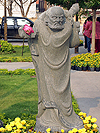
Bhadrakali
(भद्रकाली) 1.
Sanskrit. 'Blessed Kali' or 'auspicious Kali'. Hindu goddess who is the
consort of Virabhadra, who was created along with her. She arose from
the wrath of Devi after Daksha mocked and dishonored a statue of Shiva,
resulting in the suicide of Sati, another form of Devi. 2. Sanskrit.
Tantric goddess who is the consort of Bhairava.

Bhagavad
Gita (भगवद्गीता)
Sanskrit. 'Song of the divine Lord', revealed by Krishna in the
Mahabharata. Hindu religious text prescribing a moral and ethical code
of behavior emphasizing the merit of selfless service and devotion. The
text is in the form of a conversation between Krishna and Arjuna, taking
place just before the battle of Kurukshetra.

Bhairava (भैरव)
Sanskrit. 'Terrible'. The Hindu god Shiva in his
more fearful appearance as a ten armed creature wearing a bone necklace,
and a skull as a hair ornament.

Bhairavi
Sanskrit. 'Terror'. One of the evil forms of Devi,
consort of Shiva.

Bhaisajyaguru
Thai. Name of a buddha from Mahayana Buddhism who
attained Enlightenment before the historical Sakyamuni Buddha of whom he
represents the healing aspect. He is therefore also known as the Master
of Healing or Medicine Buddha. When he was still a bodhisattva he made
twelve vows to always help all living beings to be free from illness
once he would attain Enlightenment and thus became the embodiment of the
wish to free all beings from all illnesses, both physically, mentally
and spiritually. In Chinese tradition he is often depicted together with
the Sakyamuni and Amitabha Buddhas, a representation known as the
trinity Buddhas. His full name, Bhaisajyaguru Vaiduryaprabha, means
'Medicine Guru Lapis Lazuli Light' or 'Medicine Teacher whose Light is
that of Lapis Lazuli'. Lapis Lazuli is the name of a semi-precious stone
of an intense blue colour and it refers here to Bhaisajyaguru's
complexion which is dark blue. In China he is called Yaoshifo.

Bharadvaja
(भारद्वाज)
Sankrit-Thai. Name given to the arahat Pindola, leader of the Eighteen
Arahats, often to distinguish him from one of the candidates for
inclusion as the 17th or 18th arahat, who is also named Pindola. In the
Sutta he is referred to as having a voice like the lionís roar. The
Sanskrit name Bharadvaja, pronounced bhāradvāja and commonly spelled or
transcribed Bharadvajo, Bharadwaja or Bharadhvaja, is said to mean 'one
bearing vigour', and if so might rather be spelled Bharatvaja and
pronounced bharatvāja, a compound of bharat which derives from bharata
and means 'to bear', and vaja meaning 'vigour'. The name Bharadvaja is
also used for another arahat, i.e. Kanaka Bharadvaja, as well as for one
of the great sages (rishi) whose accomplishments are detailed in the
Purana. However, though the name of the latter is usually pronounced
bhāradvāja, the same as above, it may also be pronounced bharadvāja
which has a different spelling in Sanskrit. In Thai pronounced Pintohn
Pharathawat.

Bharata (भरत)
1. Sanskrit. 'Being maintained'. Half-brother of
Rama in the Indian epic Ramayana. 2. Sanskrit. 'Being maintained'. One
of the names of Agni, the Hindu god of fire.

Bhattara-Guru
A popular Javanese appearance of Shiva as a fat
ascetic with a beard and plaited hair. His attributes can be a jar,
rosary, or a fly whisk. At some stage worshiped in Java as the rishi
Agastya.

Bhavani (भाविनी)
Sanskrit. 'Provider of life'. The female creator,
one of the benevolent forms of Devi, consort to Shiva.

Bhima (भीम)
Sanskrit. Important character and protagonist in
the Indian epic the Mahabarata, famous for his strength and bravery. He
belongs to the tribe of the Pandavas, involved in the battle of
Kurukshetra. He is of enormous size and usually depicted carrying a
club. He is the son of Vayu, the Vedic god of wind or air. Also called
Bhimsena.

Bhimsena
Sanskrit. Son of Vayu, the Vedic god of wind or
air. An important character in the Indian epic the Mahabarata, famous
for his strength and bravery. He is of vast size and usually depicted
carrying a club. He is also called Bhima.

Bhumidevi
Pali-Thai. 'Goddess of the earth'. One of Vishnu's
two consorts in Hindu mythology. In Buddhism the goddess of the earth is
Mae Phra Thoranee.

Bi Gan (比干)
Name of a Chinese wealth god. He was a faithful
civilian official and the uncle of the tyrannical and concupiscent
Emperor Zhou of the Shang Dynasty, for whom he took charge of the
Imperial finances. Legend has it that to prove his loyalty he took out
his heart and presented it to the Emperor by throwing it on the floor.
But other sources say Bi Gan tried to rectify the Emperor who
consequently killed him cruelly by taking his heart out to check if he
perhaps was a saint, as it was believed that a saintís heart has seven
ventricles. Having no heart Bi Gan was impartial in the distribution of
the Emperorís wealth amongst the people and so became a Chinese civilian
wealth deity. He is also called Wen Cai Shen, the 'formal god of wealth'
who is also referred to as the 'true god of wealth'.

Bimba
Wife of prince Siddhartha with whom he had his son
Rahula at the age of twenty nine. She was the daughter of Suprabuddha,
prince of Devadaha castle and a brother of the deceased queen Maha Maya.
Also known as Gopa and Yashodhara.

Bi Xie (辟邪)
Chinese. Name of a fierce but auspicious creature
from Chinese mythology that resembles a winged lion. There is an ancient
myth that tells the creature violated a celestial law and was
consequently punished by the Jade Emperor by restricting its diet to
gold. Besides this he also prevented the creature from defecating by
sealing its anus. Thus it started a quest for the hard to get gold for
survival. Since it can only absorb gold but not expel it Bi Xie is seen
as a symbol of the acquisition and preservation of wealth. There are
different types of Bi Xie: one without horns the others with either one
or two horns. The one with one horn is called Pi Chen or Tian Lu and is
in charge of wealth. The one with two horns is known as Bi Ya or Pi Ya
and is considered to ward off evil. Bi Xie is also often transcribed as
Pi Xie and Pi Xiu.


boar
One of the avatars of the Hindu god Vishnu,
incarnated in the form of a boar, known as Varaha.

bodhidurma
(बोधीद्रुम)
Sanskrit. 'Bodhi tree'. Name for the ficus religiosa, as well as a
nickname for Bhadra, one of the eighteen arahats, who allegedly was born
underneath such a tree.

bodhisatta
Pali. A buddha-to-be and one of the 550
incarnations that precede buddhahood, in Theravada Buddhism.

bodhisattva
Sanskrit. 'One whose essence is perfect
knowledge'. A being who has attained Enlightenment or bodhi but has
postponed buddhahood in order to help others reach that goal. In
Mahayana Buddhism many bodhisattvas are personifications of divine
qualities, such as compassion (Avalokitesvara) or wisdom (Manjushri) and
are often depicted with multiple arms. In both Theravada and Mahayana
Buddhism the term is also applied to the earlier lives of the historical
Buddha called chadok and to his last life as prince Siddhartha, before
his Enlightenment. Also spelt bodhisatva and bodhisatwa. In Thai
photisat and when referring to the Buddha before his Enlightenment or to
his earlier lives, Phra Photisat (Phra Bodhisattva). In Tibetan Buddhism
they are called lama and the Dalai Lama is considered an incarnation of
the bodhisattva Avalokitesvara.

_small.jpg)
bodhi tree
Sacred fig tree in Bodh Gaya with the scientific
name ficus religiosa, also known as the 'tree of knowledge', under which
the Buddha sat when he gained Enlightenment. Its leaves have the shape
of a sacred lotus bud and are suspended upside down, that is with the
tip of the leaf pointing almost straight downwards. Because of this the
leaves actually function as a ventilating fan, causing a downward breeze
when the wind blows through the treetop's foliage, so cooling the spot
underneath it. It is supposed that this might have been a reason why
Siddhartha chose to meditate under this particular tree. After the
original bodhi tree was cut in 600 AD, cuttings were replanted wherever
Theravada Buddhism was introduced and practiced. In literature it is
often confused with a banyan tree, the tree to which the Buddha moved to
stay, seven days after he had attained enlightenment. It is often seen
in or near temples and often portrayed in art. In Sanskrit bodhidurma.


Brah Dhanari
Sanskrit. Goddess of the earth who witnessed the
accumulated merits of the Buddha, during his confrontation with Mara,
just before his Enlightenment. In Thailand known as Mae Phra Thoranee.

Brahma (ब्रह्मा)
Sanskrit. 'Prayer' or 'worship'. As the creator,
he is one of the three prominent gods of the Trimurti, the Hindu
pantheon, together with Shiva, the destroyer and Vishnu, the preserver.
He is often described as the director of the universe, the balance
between the opposing forces of Vishnu and Shiva. He is brought forth
from the golden lotus which grows from the navel of Vishnu during his
cosmic sleep, in order to begin each new round of creation. In art
usually depicted with four heads and four arms, but may have as many as
eight arms. His attributes are a disc, ladle, sceptre, a string of beads
which he uses to keep track of the universe's time and symbolizes the
substances used in the progress of creation, a bow, water jug, fly whisk
and the Vedas. His mount is the Hamsa, a sacred swan, and his consort
Sarasvati, the goddess of learning. In Buddhist art he is frequently
depicted with one head and two arms along with Indra as an attendant of
the Buddha. With a linga Brahma is symbolized in the cube shaped base.
His symbol as the creator is the Ohm sign.


Brahmacharya (ब्रह्मचर्य)
Sanskrit. Practice in which a person dedicates his
life to the quest for a personal realization of brahman, the Universal,
absolute, eternal and pervading spirit in Hindu philosophy. This
involves going to live with a spiritual teacher (acharya) under whom the
apprentice practices a life of moral restraint and strict celibacy,
whilst dedicating himself to the learning of the dharma. The Thai word
for acharya is ajaan (achan), a word reminiscent of the Sanskrit word
ajaani which means 'having no wife', whereas Brahmacharya is in Thai
called Phrommachan, a term also used for celibacy. In Hindu tradition it
is considered a stage of life known as the first ashram.

Brahma heavens
The sixteen heavens, without sensory perception,
that exist above the six lower heavens in Buddhist mythology.

brahman (ब्राह्मण)
1. Sanskrit. Universal, absolute, eternal and
pervading spirit in Hindu philosophy. It is the source of all creation,
animate and inanimate, from which all things emanate and to which all
return. The supreme divine Hindu reality. 2. Follower of Brahmanism
prior to the development of Hinduism. 3. Hindi-Sanskrit. Highest social
caste (varna) in Hinduism, and the only one from which a priest can
come. In Hindi-Sanskrit pronounced brahmana. 4. A priest of Brahma.

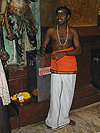
Brahmanaspati
Sanskrit. A composite animal combining features of
the mounts of the three main Hindu gods, thus having the beak of
Vishnu's Garuda, the horns of Shiva's bull, and the wings of Brahma's
hamsa. This creature depicted with Buddha mounted, represents the
ascendancy of Buddhism over Hinduism.

brahman cord
Small white cord worn over the left shoulder by
brahman priests, crossing their chest. Also seen in iconography,
sometimes in the form of a snake.

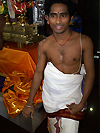
Brahmanism
An early form of Hindu religion during the Vedic
period in India, based on faith in Brahma. It was brought to India by
the Aryan migrants during the second millennium BC and later Hinduism
and Buddhism emanated from it.

Brihaspati
Sanskrit. 'Lord of prayer'. An Arian deity in the
Vedic period. He was worshiped as a great sage and served as a teacher
and model to other gods. He is associated with the planet Jupiter.

Budai (布袋)
Chinese. 'Cloth Bag'. According to tradition,
Budai was a Chinese monk who lived during the Later Liang Dynasty (907 -
923 AD). He is represented as carrying a large purse (cloth sack or
cloth bag) which never empties and is filled with precious items, as
well as with the woes of the world which he removes. He is often
depicted accompanied by children, whereof he is the patron. Besides this
he is also the benefactor of the weak and the poor. In Chinese he is
also known by the name is Huan Xi Fo which translates as happy buddha,
also referred to as smiling buddha as well as the Loving One, the
Friendly One, Maitreya or Mi Le Fo, and as the Budai Luohan, which
associates him with Angaja or Ingada (อิงคท), one of the original
eighteen arhats of Buddhism, who in Chinese art is often portrayed as
Budai. Due to his benevolent nature he is often worshipped as an
informal Chinese wealth god. In Thailand he is often confused with Phra
Sangkatjaai. Sometimes transcribed Pu Tai or Pu-Tai and also pronounced
Hotei.


Buddha (बुद्ध)
Sanskrit. 'The one who is enlightened' or 'the
awakened one'. One who has achieved the highest knowledge of truth and
is thereby freed from all further rebirth and has passed into nirvana.
Name for the Shakyamuni or historical Buddha known as Siddhartha
Gautama, who gained Enlightenment in 563 BC (544 BC according to
Theravada doctrine - see BE) and founded Buddhism as a religion. He was
born as a prince of the Shakya clan and his father Suddhodana ruled over
the kingdom of Kapilavasthu in present day Nepal. The basis of his
teachings are the Four Noble Truths of which the last one is the
revelation of the Eightfold Path that results in nirvana. In Hinduism he
is the ninth incarnation of Vishnu. His vehicle is a white ox and the
four stages in his life are represented by four animals, i.e. an
elephant, a lion, a bull and a horse.

buddha eye
A name sometimes given to a whorl of hair between
the eyebrows of some deities and usually known as urna. It emits rays of
light that illuminate the world and represent great wisdom. It is one of
the signs of an enlightened being. In oriental iconography often
indicated as a round mark, sometimes called a third eye.

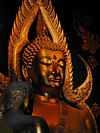
Buddhapada
Sanskrit. 'Footprint of the Buddha'. According to
legend these footprints actually show where the Buddha walked on earth.
In Thailand they are called Phraphutthabaht and are found in temples all
over the country where they are worshipped as a reminder of his
doctrine. It is usually a large, horizontal sculpture resembling a
footprint with iconographic symbols on its sole, which can also be seen
on the bottom of some reclining Buddha images and represent the 108
signs of a buddha. The story relates the legend of a footprint of the
Buddha found in Thailand. A group of Thai monks visiting Sri Lanka were
surprised to learn from their Singhalese counterparts that, according to
scriptures, a footprint of the Buddha existed in Thailand. They ordered
a search and it was eventually found by a hunter. The hunter had chased
a wounded deer that after drinking from a well was suddenly healed. On
investigation the hunter found a pool in the shape of a footprint,
filled with water. When he drank from it he also was miraculously cured
from a skin disease.


Buddhavamsa
Sanskrit. Mythological chronicles relating the
story of the 24 buddhas that preceded the historical Buddha, Siddhartha
Gautama, and announce the coming of the Maitreya Buddha.

Buddhism
Religion based on the dhamma or teachings of the
historical Buddha, Siddhartha Gautama. It emphasizes compassion for all
sentient beings, non-attachment, and release from suffering through the
attainment of Enlightenment, which can be achieved by following the Four
Noble Truths and the Eightfold Path. After the Buddha's death two main
directions of Buddhism evolved: the school of Mahayana and the school of
Theravada or Hinayana. In Sanskrit Bauddhadharma.

buffalo
Mount of the Vedic god Yama. Nondi, the mount of
the god Ishana is said to be a buffalo although other sources mention
Nondi as being a bull.

bull
Vahana or vehicle of the Hindu god Shiva known as
Nandi, the symbol of male strength, virility, and potency. Also found in
pre-Arian art of the Indus Valley civilization. Together with the
elephant, the lion and the horse, it is one of the four animals, that
represent the four stages in the life of the Buddha.

 |